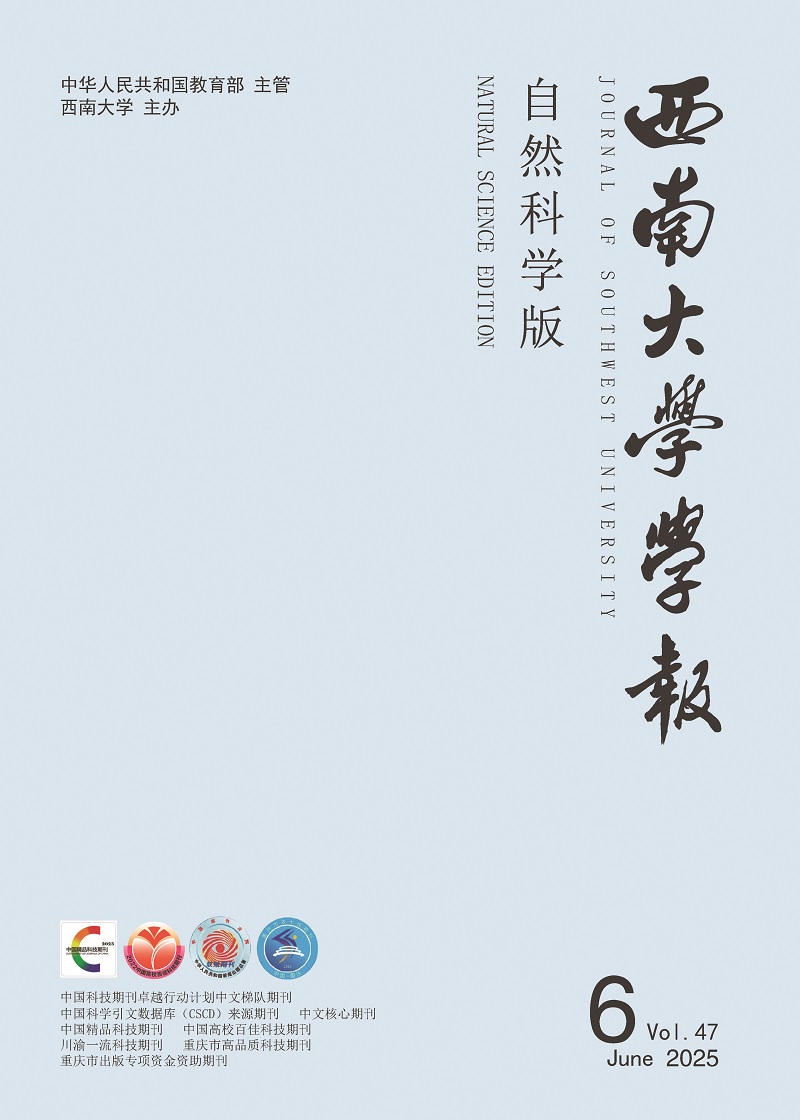-
正则半群的逆断面[1]的概念于1982年引入.若正则半群S的逆子半群So含S的每个元素的唯一逆元,则称So为S的逆断面.在逆断面情形下,文献[2]引入了两个子半群R和L,文献[3]证明了两个幂等子集I和Λ都是带.作为逆断面的推广,恰当断面[4]的概念于1993年引入到富足半群中,文献[4]建立了具有可乘型A断面的富足半群的结构.文献[5]引入了两个幂等子集I和Λ,并研究了恰当断面的若干性质.文献[6]引入并研究了两个重要子集R和L,建立了具有拟理想恰当断面的富足半群的织积结构.文献[7]建立了具有左单S-恰当断面的富足半群的结构,文献[8]利用左正则带和
${{\mathscr L}^ * }$ -幂单半群,建立了具有S-恰当断面的富足半群的结构,但这两个半群是不对称的.文献[9]得到了完全正则半群簇的子簇的两种分解.文献[10]得到了变换半群的一个组合结果.文献[11-12]进一步讨论了恰当断面的性质,并研究了拟理想恰当断面的乘积问题.文献[13]对拟理想恰当断面的乘积问题进行了推广.文献[14]研究了可乘拟恰当断面的好同余.本文的主要目的是利用两个对称的半群${{\mathscr L}^ * }$ -幂单半群和${{\mathscr R}^ * }$ -幂单半群,建立具有良恰当断面的富足半群的结构.如果半群S的每一
${{\mathscr L}^ * }$ -类和${{\mathscr R}^ * }$ -类都含幂等元,则称S为富足半群[15].幂等元集成带(半格)的富足半群称为拟恰当半群(恰当半群)[16].恰当半群的每一${{\mathscr L}^ * }$ -类La*和${{\mathscr R}^ * }$ -类Ra*仅含一个幂等元,分别记作a*和a+.用符号E和Eo分别表示半群S和So的幂等元集.设U是富足半群S的富足子半群.如果对任意a∈U,存在两个幂等元e∈La*(S)∩U和f∈Ra*(S)∩U,则称U为S的*-子半群.设So是富足半群S的*-恰当子半群.如果对任意x∈S,存在幂等元e,f∈E和唯一x ∈So,使得x=exf,这里
$e{\overline {{\mathscr L}x} ^ + }$ ,$f{\overline {{\mathscr R}x} ^ * }$ ,则称So为S的恰当断面.易知e和f是由x和So唯一确定的,分别记为ex和fx,且有ex${{\mathscr R}^ * }$ x${{\mathscr L}^ * }$ fx.记如果I和Λ都是带,则称So为S的良恰当断面.据文献[5]的命题2.3知,若So是S的良恰当断面,则I是左正则带(iji=ij),Λ是右正则带(iji=ji).幂等元集成右正则带(左正则带)的拟恰当半群称为
${{\mathscr L}^ * }$ -幂单半群(${{\mathscr R}^ * }$ -幂单半群).本文未定义的概念和符号见文献[6, 15-16].引理1[8] 设S是具有恰当断面So的富足半群.若I(Λ)是子半群,则R(L)也是子半群,从而R(L)是拟恰当半群.
在下文中,R表示一个具有恰当断面So的
${{\mathscr R}^ * }$ -幂单半群.则易知,对任一x∈R,有fx=x*∈Eo和x=exx.对${{\mathscr L}^ * }$ -幂单半群L有对偶的结论.下面给出本文的主要定理.定理1 设
${{\mathscr R}^ * }$ -幂单半群R和${{\mathscr L}^ * }$ -幂单半群L具有一个共同的恰当断面So.对任一a∈L,设ϕa:R→R,$y \mapsto {\phi _a}y$ 为映射;对任一x∈R,设ψx:L→L,$b \mapsto b\psi _x$ 为映射.在集合U=R×L={(x,a)∈R×L:x=a}上定义乘法假设对任意a,b∈L和任意x,y∈R,下列条件满足:
(ⅰ)
$\overline {{\phi _a}y} = \overline {a{\psi _y}} $ ;(ⅱ)若x=b,则ϕa(ex(ϕby))=eϕax(ϕ(aψx)fby)且(aψex(ϕby))fbψy=((aψx)fb)ψy;
(ⅲ)若a∈So,则ϕay=ay且aψy=ay;若x∈So,则bψx=bx且ϕax=ax;
(ⅳ) ea(ϕax)=ϕax且(aψx)fx=aψx;
(ⅴ)对任一c∈L及z∈R,若ϕay=ϕaz及(aψy)fb=(aψz)fc,则ϕfay=ϕfaz且(faψy)fb=(faψz)fc;若ey(ϕbx)=ez(ϕcx)及bψx=cψx,则ey(ϕbex)=ez(ϕcex)且bψex=cψex.
则U是具有同构于So的良恰当断面的富足半群.
反之,每一个具有良恰当断面的富足半群都可以这样构造.
定理1由下面几个引理逐步证得.
引理2 U上的乘法是有定义的.
证 只须证(ex(ϕay),(aψy)fb)∈U.
因ϕa:R→R和ψy:L→L是映射,显然有
因E(R)是左正则带,且
据条件(ⅰ)和(ⅳ),有
且
故
$\overline {{e_{x\left( {{\phi _a}y} \right)}}} = \overline {{\phi _a}y} $ .类似地,$\overline {\left( {a{\psi _y}} \right){f_b}} = \overline {a{\psi _y}} $ .据条件(ⅳ),有故
引理3 U是半群.
证 设(x,a),(y,b),(z,c)∈U.则
而
由y=b,据条件(ⅱ),有
所以U是半群.
引理4 设(x,a)∈U.则(x,a)∈E(U)当且仅当ϕax=aψx=a=x.
证 因
注意到x∈R和a∈L,易知:若
则
故(x,a)∈E(U).反之,若(x,a)∈E(U),则ex(ϕax)=x且(aψx)fa=a.据(x,a)∈U和a∈L,有
$ {e_x}{\overline {{\mathscr L}x} ^ + }$ =a+=ea.故类似地,aψx=a=x.
引理5 假设(x,a)∈U,记u=(ex,x+)和v=(a*,fa).则u,v∈E(U)且
$u{{\mathscr R}^ * }$ (x,a)${{\mathscr L}^ * }v$ .证 据引理4,显然有u,v∈E(U).令x∈Eo,a∈L,因为xfa=xfa=a,则
假设(y,b),(z,c)∈Γ1,使得
则
即
且
故
据fa
${{\mathscr R}^ * }$ a*=x*=fx和条件(ⅳ),有bψx=cψx.因此据条件(ⅴ),有且
所以
故(x,a)
${{\mathscr R}^ * }u$ .对偶地,有(x,a)${{\mathscr L}^ * }v$ .引理6 U是富足半群.
证 据引理5可得.
引理7 设W={(s,s):s∈So}.则W是同构于So的U的恰当*-子半群.
证 显然W⊆U.设(s,s),(t,t)∈W.易知
所以W是子半群.对任一s∈So,定义sφ=(s,s),显然φ是一个同构.故So
$ \cong $ W.为证W是*-子半群,设(s,s)∈W.据引理4和引理5,有
且
$u{{\mathscr R}^ * }$ (s,s).类似地,v=(s*,s*)∈E(W)且$v{{\mathscr L}^ * }$ (s,s).引理8 设(x1,a1),(x2,a2)∈U.则:
(ⅰ) (x1,a1)
${{\mathscr R}^ * }$ (x2,a2)当且仅当x1${{\mathscr R}^ * }$ x2;(ⅱ) (x1,a1)
${{\mathscr L}^ * }$ (x2,a2)当且仅当a1${{\mathscr L}^ * }$ a2.证 为证(ⅰ),据引理5,只需证明(ex1,
${\overline {{x_1}} ^ + }$ )${{\mathscr R}^ * }$ (ex2,${\overline {{x_2}} ^ + }$ )当且仅当x1${{\mathscr R}^ * }$ x2.若x1
${{\mathscr R}^ * }$ x2,则ex1=ex2,故${\overline {{x_1}} ^ + }$ =${\overline {{x_2}} ^ + }$ .因此反之,若
则u1u2=u2且u2u1=u1.故
且
即ex1ex2=ex2,且ex2ex1=ex1.故ex1
${{\mathscr R}^ * }$ ex2.所以x1${{\mathscr R}^ * }$ x2.(ⅱ)可对偶地证明.
引理9 W是U的恰当断面.
证 对任意的t=(x,a)∈U,记
易验证t=ettft.而且
假设t可以写成另一种形式t=et′t′ft′,其中
及
根据引理8的证明,有
由et
${{\mathscr R}^ * }$ t${{\mathscr R}^ * }$ et′知类似地,有fa=fb2,
${\overline a ^ * } = {\overline {{b_2}} ^ * }$ .所以,由b1∈L及y2∈R知从而
因et′,ft′∈E(U),根据引理4,有
$\overline {{b_1}} {y_1} = \overline {{y_1}} $ 且${b_2}\overline {{y_2}} = \overline {{b_2}} $ .因y1∈R,有故y1
${{\mathscr L}^ * }$ $\overline {{y_1}} $ ${{\mathscr L}^ * }$ $\overline {{y_1}}^* $ .从$\overline {{b_1}} {y_1} = \overline {{y_1}} $ 可推断出$\overline {{y_1}} = \overline {{y_1}}{y_1} $ .因$\overline {{b_1}} = \overline {{y_1}} $ ,从而$\overline {{y_1}} ^*= \overline {{y_1}} ^*{y_1}$ ,故因此y1是幂等元,且y1=ey1=ex.类似地,有
易知
故et′=et且ft′=ft.从而
故x=exy.由x=exx知exy=exx,可得x+y=x.显然
$\overline {{x}} ^+ = \overline {{b_1}}=\overline {{b_1}}^* =\overline {y}^+$ ,故x=y+y=y.所以,W是U的恰当断面.引理10 W是U的良恰当断面.
证 设
对任一(x,a)∈I(U),有(x,a)∈E(U),且存在(y,y)∈E(W),y∈Eo,使得(x,a)
${{\mathscr L} }$ (y,y).则(a*,fa)${{\mathscr L} }$ (y,y),故(a*,fa)=(y,y),即a*=y=fa.故a∈R∩L=So,根据引理4,有a=ϕax=ax.因(x,a)∈U,有x=a=a,故x=xx.从引理9的证明可推断出x是幂等元,故x=ex.从而因此
对任一(x,a)∈U,其中x2=x及a∈Eo,显然有
所以I(U)=E(R)|×|Eo
$ \cong $ E(R)是左正则带.对偶地,Λ(U)=Eo|×|E(L)$ \cong $ E(L)是右正则带.据定义知W是U的良恰当断面.至此完成了定理1正面部分的证明.
反之,假设S是富足半群,具有良恰当断面So.则I是左正则带,Λ是右正则带.从而,R是
${{\mathscr R}^ * }$ -幂单半群,L是${{\mathscr L}^ * }$ -幂单半群,且R和L分享一个共同的恰当断面So.对任一a∈L及x∈R,设为映射.则它们满足下列条件:
(ⅰ)因
及
${e_{ay}}{\overline {{\mathscr L}ay} ^ + }$ ,有$\overline {{\phi _a}y} = \overline {a{_y}} $ .类似地,因及
${f_{ay}}{\overline {{\mathscr R}ay} ^ * }$ ,有$\overline {a{\psi _y}} = \overline {ay} $ .故$\overline {{\phi _a}y} = \overline {a{\psi _y}} $ .(ⅱ)由x=b,x∈R及b∈L知
计算得
故
类似地,有
(ⅲ)若a∈So,则ay∈SoR⊆R,故fay=ay*.所以
对偶地,若x∈So,则bψx=bx,且ϕax=ax.
(ⅳ)易知
(ⅴ)最后证明:若bψx=cψx及ey(ϕbx)=ez(ϕcx),则
因ebx=ebex,由Eo是半格,有
$\overline {{bx}}^+ = \overline {{be_{x}}}^+ $ .类似地,$\overline {{cx}}^+ = \overline {{ce_{x}}}^+ $ .从bψx=cψx可推断出所以
$ {\overline {b{e_x}} ^ + }b{e_x} = {\overline {c{e_x}} ^ + }c{e_x}$ ,从而bψx=cψx.若ey(ϕbx)=ez(ϕcx),则eyebxbx =ezecxcx.因bψx=cψx,有$\overline {b{\psi _x}} = \overline {c{\psi _x}} $ ,据(ⅰ),bx =cx.从而故eyebx=ezecx.所以eyebex=ezecex.类似地,因bψex=cψex,有
$\overline {b{e_x}} = \overline {c{e_x}} $ ,故从而
即
对偶地,若ϕay=ϕaz及(aψy)fb=(aψz)fc,则
所以得到一个富足半群U.最后证明U同构于S.
设(x,a)∈U.定义θ:U→S为θ((x,a))=exa,则θ是有定义的,且θ是单射.事实上,若
其中x,y∈R,a,b∈L.则从exa=exafa,
$f_a{\overline {{\mathscr R}a} ^ * } $ 和$e_x{\overline {{\mathscr L}x} ^ + } = {\overline a ^ + }$ 可推断出$\overline {{e_x}a} = \overline a $ .类似地,$\overline {{e_y}b} = \overline b$ ,故a=b.从而所以
类似地,a=b.
对任意(x,a),(y,b)∈U,因yfb=eyb,有
故θ是同态.对任一x∈S,易验证xx*∈R且x+x∈L.而且,从
和
可推断出
$\overline {x{{\overline x }^ * }} = \overline x = \overline {{{\overline x }^ + }x} $ .故$\left( {x{{\overline x }^ * }, {{\overline x }^ + }x} \right)$ ∈U且这就说明θ是满射.所以θ是一个同构.
A Structure of Abundant Semigroups with Good Adequate Transversals
- Received Date: 29/05/2018
- Available Online: 20/10/2019
-
Key words:
- abundant semigroup /
- good adequate transversal /
- ${{\mathscr L}^ * }$-unipotent semigroup" type="keywords.keywordEn" href='javascript:void(0);'>
${{\mathscr L}^ * }$
Abstract: By means of an ${{\mathscr L}^ * }$-unipotent semigroup and an ${{\mathscr R}^ * }$-unipotent semigroup, a symmetrical spined product structure theorem for an abundant semigroup with a good adequate transversal is established. This conclusion removes "quasi-ideal"-an important premise-thus making it more concise than the conclusions in available literature. The result of this paper is an improvement and extension of the previous results about inverse transversals and adequate transversals. It lays a solid theoretical foundation for further study of the structure, properties and characterization of the congruences on this kind of semigroups.






 DownLoad:
DownLoad: